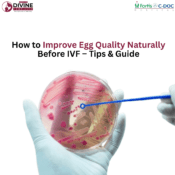

How In Vitro Fertilization Has Evolved Over the Last 40 Years
Introduction
In vitro fertilization (IVF) stands as one of the most groundbreaking achievements in medical science, offering hope to millions of couples facing fertility challenges. When the first IVF baby, Louise Brown, was born in 1978, it marked a new era in reproductive medicine. At the time, the concept of creating life outside the human body was revolutionary and stirred excitement, skepticism, and ethical debate alike.
Fast-forward more than 40 years, and IVF has undergone tremendous evolution. The success rates have soared, the procedures have become safer, and the range of people who can benefit from IVF has dramatically expanded—including single parents, LGBTQ+ individuals, and cancer survivors seeking fertility preservation. This blog traces the evolution of IVF, highlighting how far we’ve come from the earliest attempts to today’s high-tech, personalized treatments.
For aspiring parents, understanding the history of IVF, its progress, and what lies ahead can provide comfort, clarity, and confidence in choosing the best fertility path. Let’s embark on a journey through the decades of IVF innovation.
The Early Days of IVF (1970s–1980s)
The seeds of IVF were planted long before Louise Brown’s birth. In the 1970s, British scientists Dr. Robert Edwards and Dr. Patrick Steptoe were experimenting with ways to fertilize human eggs outside the body. After years of trial, error, and public scrutiny, they successfully brought the first IVF baby into the world on July 25, 1978.
This breakthrough laid the foundation for what was then a highly experimental and controversial procedure.
Key Milestones in the 1970s–1980s:
- 1978: Birth of Louise Brown in the UK – the world’s first IVF baby.
- 1981: First IVF baby born in the U.S.
- 1986: India’s first IVF baby, Harsha Chawda, was born, thanks to the pioneering work of Dr. Indira Hinduja and her team.
Techniques and Challenges:
- The original IVF technique involved natural ovulation without hormonal stimulation.
- Early methods required surgical retrieval of eggs, which was invasive and risky.
- Success rates were extremely low (less than 10%).
Public Perception and Ethics:
- IVF sparked widespread ethical and religious debates about “playing God.”
- Many questioned the safety and morality of creating life outside the womb.
Technological Advances in the 1990s
The 1990s marked the beginning of a technological boom for IVF, transforming it from an experimental solution to a mainstream medical treatment.
Major Breakthroughs:
- 1992 – Introduction of ICSI (Intracytoplasmic Sperm Injection): Revolutionized male infertility treatment by allowing a single sperm to be injected directly into the egg.
- Cryopreservation (Embryo Freezing): Allowed surplus embryos to be stored for future use.
- Improved Culture Media: Better lab conditions enhanced embryo quality and survival rates.
IVF Success Rate Improvements:
By the late 1990s, IVF success rates had doubled compared to the 1980s, reaching approximately 25–30% per cycle, depending on age and clinic quality.
IVF in the 2000s: Refinement and Personalization
The 2000s were all about refining IVF protocols and making the treatment more patient-specific and safe.
Innovations:
- Preimplantation Genetic Testing (PGT): Enabled the screening of embryos for genetic disorders before transfer.
- Vitrification: A rapid freezing technique that improved the survival rates of eggs and embryos.
- Ovarian Stimulation Protocols: Became more customized, reducing side effects and improving outcomes.
- Single Embryo Transfer (SET): Reduced the risks of multiple pregnancies while maintaining success rates.
Accessibility and Awareness:
- IVF became more widely available and socially accepted.
- Clinics began to emphasize emotional support and counseling.
Modern IVF: 2010s–2020s
We are now in the era of precision IVF, where artificial intelligence, automation, and advanced imaging are reshaping treatment strategies.
High-Tech Developments:
- Time-Lapse Embryo Imaging: Offers real-time embryo development monitoring without disrupting the culture environment.
- AI and Machine Learning: Assist in embryo selection, predicting which embryos have the highest implantation potential.
- Personalized Medicine: Genetic and hormonal profiles are used to customize protocols for each individual.
New Frontiers:
- Fertility Preservation: IVF is now used not just for infertility but also for social egg freezing and preservation in cancer patients.
- Fertility Tourism: Countries like India have emerged as affordable IVF destinations with top-tier facilities.
- IVF is increasingly inclusive—benefiting LGBTQ+ couples and single individuals.
IVF in India: A Local Perspective
India’s IVF journey began in the 1980s, with significant milestones that have made it a global fertility hub.
Historical Context:
- 1978: Dr. Subhas Mukherjee claims the birth of India’s first IVF baby, but recognition came late.
- 1986: Dr. Indira Hinduja successfully delivered Harsha, officially recognized as India’s first test-tube baby.
Growth of IVF in India:
- A boom in IVF centers across metro cities like Delhi, Mumbai, and Bangalore.
- Emergence of specialized centers such as Mother Divine Fertility, known for affordable, world-class care.
Regulation and Ethics:
- The Assisted Reproductive Technology (Regulation) Bill introduced to standardize practices.
- Guidelines by ICMR (Indian Council of Medical Research) ensure ethical and safe procedures.
Changing Success Rates Over Time
The evolution of IVF is best reflected in its dramatic improvement in success rates.
Then vs Now:
- 1980s: Success rates below 10%
- 2020s: Success rates around 40–60% for women under 35 in top clinics
Key Factors:
- Better embryo quality due to culture media and time-lapse imaging.
- Genetic testing to identify viable embryos.
- Single embryo transfer reduces complications while maintaining efficacy.
Social and Ethical Evolution
IVF isn’t just a scientific journey—it’s a social one too. Over the decades, societal attitudes, regulations, and ethical considerations have evolved dramatically.
Social Acceptance:
- IVF is now mainstream, with many celebrities openly sharing their IVF journeys.
- Stigma around infertility has decreased, especially in urban India.
Ethical Conversations:
- Ongoing debates around embryo disposal, surrogacy, donor anonymity, and gene editing.
- Growing support for LGBTQ+ rights and single-parent access to fertility care.
- Legal updates like India’s surrogacy law restrict commercial surrogacy but allow altruistic surrogacy.
Future of IVF: What’s Next?
As we look ahead, the future of IVF holds exciting possibilities and challenges.
Emerging Technologies:
- CRISPR and Genetic Editing: May one day allow for the correction of genetic disorders at the embryo stage.
- Stem Cell-Derived Gametes: Scientists are working on turning stem cells into sperm or eggs.
- Non-Invasive Embryo Testing: Techniques like spent culture media analysis are being explored.
- Robotics and Automation: Robotic micromanipulation could reduce human error in labs.
Outlook:
- IVF will become more efficient, accurate, and accessible.
- Automation and AI will further personalize treatment plans.
- Global collaboration in fertility research will accelerate progress.
Conclusion
From a bold experiment in the 1970s to a widely accepted and highly effective treatment today, the evolution of IVF is nothing short of extraordinary. The journey has been filled with breakthroughs, ethical debates, technological triumphs, and, most importantly, millions of success stories.
For hopeful parents, the road to conception through IVF is now safer, more personalized, and more hopeful than ever before. Whether you're exploring IVF for the first time or considering it after other treatments, understanding its rich history and promising future can empower you to make informed choices.
IVF Timeline Infographic (Visual – Optional)
- 1978: First IVF baby (Louise Brown)
- 1986: India’s first IVF baby (Harsha)
- 1992: ICSI introduced
- 2005: Vitrification method improves freezing success
- 2010: Time-lapse imaging introduced
- 2020s: AI, genetic screening, and personalized protocols dominate
FAQs
Q: Who was the first IVF baby?
A: Louise Brown, born in the UK in 1978, was the world’s first IVF baby.
Q: What was the success rate of IVF in the 1980s?
A: Less than 10%, due to limited technology and understanding of embryo development.
Q: How has IVF changed in India?
A: From a few experimental cases to thousands of clinics, India is now a global IVF leader with growing regulation and accessibility.
Q: What is the biggest advancement in IVF so far?
A: ICSI and vitrification significantly improved success rates; today, AI and genetic testing are driving further innovation.
Q: Is IVF safer today than it was in the past?
A: Yes, advances in lab technology, personalized protocols, and better embryo selection have made IVF much safer and more effective.





